A Novel Groundwater Burial Depth Prediction Model Based on Two-Stage Modal Decomposition and Deep Learning
Abstract
1. Introduction
2. Models and Methods
2.1. CEEMDAN Model
2.2. VMD Model
2.3. CNN Principle Structure
2.4. Subsection
2.5. CEEMDAN-VMD-CNN-GRU Model
2.6. Evaluation Indicators
3. Case Studies
3.1. Data Sources
3.2. CEEMDAN Primary Modal Decomposition
3.3. VMD Secondary Modal Decomposition
3.4. CNN-GRU Model Prediction
3.5. Comparative Analysis
4. Discussion
- Prediction using CNN or GRU alone is less effective. The CEEMDAN-GRU model has 21.40% and 20.63% lower MAE and RMSE and 10.65% higher prediction accuracy than the single prediction model GRU. The “decomposition-prediction” model has significant advantages for dealing with uncertain, non-stationary and non-linear series data.
- S CNN-GRU can effectively extract the coupling relationship and temporal correlation implied by the time series and improve the prediction accuracy. the CEEMDAN-CNN-GRU model reduces the prediction result error indicators MAE and RMSE by 20.46% and 15.08% compared with the CEEMDAN-GRU model and improves the prediction accuracy by 4.55%.
- The CEEMDAN-VMD-CNN-GRU model has the lowest MAE and RMSE and 94% prediction accuracy compared to the other models, indicating that the model outperforms the other models in terms of prediction performance.
- The CEEMDAN-VMD-CNN-GRU model has the advantage of being computationally fast, with few input parameters and no need to consider the physical mechanisms of intermediate processes, requiring only the search for the best mapping relationship between input and output variables, offering more options for all types of hydrological forecasting.
- The model input data are the average groundwater depth of the People’s Victory Canal irrigation area, which does not take into account the spatial distribution of groundwater depth, which is a shortcoming and limitation of the model prediction and a direction for improvement in the future.
5. Conclusions
Author Contributions
Funding
Institutional Review Board Statement
Informed Consent Statement
Data Availability Statement
Acknowledgments
Conflicts of Interest
References
- Guo, T.; Song, S.; Shi, J.; Li, J. Groundwater Depth Forecasting Using Configurational Entropy Spectral Analyses with the Optimal Input. Ground Water 2020, 58, 749–758. [Google Scholar] [CrossRef] [PubMed]
- Yu, H.; Gong, H.; Chen, B.; Liu, K.; Gao, M. Analysis of the influence of groundwater on land subsidence in Beijing based on the geographical weighted regression (gwr) model. Sci. Total Environ. 2020, 738, 139405. [Google Scholar] [CrossRef] [PubMed]
- Liu, Q.; Gui, D.W.; Zhang, L.; Niu, J.; Dai, H.; Wei, G.H.; Bill, X.H. Simulation of regional groundwater levels in arid regions using interpretable machine learning models. Sci. Total Environ. 2022, 831, 154902. [Google Scholar] [CrossRef] [PubMed]
- Seo, S.B.; Sinha, T.; Mahinthakumar, G.; Sankarasubramanian, A.; Kumar, M. Identification of dominant source of errors in developing streamflow and groundwater projections under near-term climate change. J. Geophys. Res. Atmos. 2016, 121, 7652–7672. [Google Scholar] [CrossRef]
- Fan, Y.; Li, H.; Miguez-Macho, G. Global patterns of groundwater table depth. Science 2013, 339, 940–943. [Google Scholar] [CrossRef] [PubMed]
- Husna, N.E.A.; Bari, S.H.; Hussain, M.; Rahman, M. Ground water level prediction using artificial neural network. Int. J. Hydrol. Sci. Technol. 2016, 6, 371–381. [Google Scholar] [CrossRef]
- He, L.; Hou, M.Q.; Chen, S.Z.; Zhang, J.R.; Chen, J.Y.; Qi, H. Construction of a spatio-temporal coupling model for groundwater level prediction: A case study of Changwu area, Yangtze River Delta region of China. Water Supply 2021, 21, 3790–3809. [Google Scholar] [CrossRef]
- Liu, X.; Han, Y.P.; Huang, H.P. Research on groundwater burial depth prediction method based on BiLSTM-NFC. Yellow River 2021, 43, 80–85. [Google Scholar] [CrossRef]
- Fu, Z.Y.; Chen, W.Q.; Tang, W.X.; Long, J.J.; Zeng, S.B. Prediction of groundwater depth of burial on slopes of residual soils based on CEEMD-RF model. Yangtze River 2020, 35, 141–148. [Google Scholar] [CrossRef]
- Liang, Q.Z.; Wang, L.Q.; Liu, D.; Li, G.X. EEMD-based regional groundwater burial depth PSO-ELM prediction model. Water Resour. Hydropower Eng. 2020, 51, 45–51. [Google Scholar] [CrossRef]
- Yin, H.; Ou, Z.H.; Chen, D.; Meng, A.B. Ultra-short-term wind power forecasting based on quadratic pattern decomposition and cascading deep learning. Power Syst. Technol. 2020, 44, 445–453. [Google Scholar] [CrossRef]
- Wang, D.; Wei, S.; Luo, H.; Yue, C.; Grunder, O. A novel hybrid model for air quality index forecasting based on two-phase decomposition technique and modified extreme learning machine. Sci. Total Environ. 2017, 580, 719–733. [Google Scholar] [CrossRef]
- Luo, W.H.; Dong, B.T.; Wang, Z.S. Short-time traffic flow prediction based on CNN-SVR hybrid deep learning model. J. Transp. Syst. Eng. Inf. Technol. 2017, 17, 68–74. [Google Scholar] [CrossRef]
- Chen, J.P.; Hu, Z.J.; Chen, W.N.; Gao, M.X.; Du, Y.X.; Lin, M.R. Quadratic modal decomposition combining DBiLSTM-MLR for integrated energy system load forecasting. Autom. Electr. Power Syst. 2021, 45, 85–94. [Google Scholar] [CrossRef]
- Wu, Z.; Huang, N.E. Ensemble empirical mode decomposition: A noise-assisted data analysis method. Adv. Adapt. Data Anal. 2011, 1, 1–41. [Google Scholar] [CrossRef]
- Yeh, J.R.; Shieh, J.S.; Huang, N.E. Complementary ensemble empirical mode decomposition: A novel noise enhanced data analysis method. Adv. Adapt. Data Anal. 2010, 2, 135–156. [Google Scholar] [CrossRef]
- Torres, M.E.; Colominas, M.A.; Schlotthauer, G.; Flandrin, P. A Complete Ensemble Empirical Mode Decomposition with Adaptive Noise. In Proceedings of the 2011 IEEE International Conference on Acoustics, Speech and Signal Processing (ICASSP), Prague, Czech Republic, 22–27 May 2011. [Google Scholar]
- Kala, A.; Vaidyanathan, S.G.; Femi, P.S. CEEMDAN hybridized with LSTM model for forecasting monthly rainfall. J. Intell. Fuzzy Syst. 2022, 43, 2609–2617. [Google Scholar] [CrossRef]
- Jinag, Y.H.; Zhu, Y.X.; Yang, X.W.; Jiang, X.W. A method for partial discharge feature extraction based on Hankel-SVD-CEEMDAN improved thresholding. Power Syst. Technol. 2022, 46, 4557–4567. [Google Scholar] [CrossRef]
- Liu, X.; Song, Q.H. Ceemdan adaptive threshold denoising algorithm for seismic directions. J. Chongqing Univ. 2019, 42, 95–104. [Google Scholar] [CrossRef]
- Dragomiretskiy, K.; Zosso, D. Variational mode decomposition. IEEE Trans. Signal Process. 2014, 62, 531–544. [Google Scholar] [CrossRef]
- Bi, G.H.; Zhao, X.; Li, L.; Chen, S.L.; Chen, C.P. A short-term wind speed prediction model with dual-mode decomposition CNN-LSTM integration. Acta Energ. Sol. Sin. 2022, 44, 1–10. [Google Scholar] [CrossRef]
- Zhang, S.Q.; Li, J.; Jiang, A.Q.; Huang, J.; Liu, H.T.; Ai, H.K. Novel two-stage short-term electricity load forecasting based on FPA-VMD and BiLSTM neural networks. Power Syst. Technol. 2022, 46, 3269–3279. [Google Scholar] [CrossRef]
- Lecun, Y.; Bottou, L. Gradient-based learning applied to document recognition. Proc. IEEE 1998, 86, 2278–2324. [Google Scholar] [CrossRef]
- Zhou, F.Y.; Jin, L.P.; Dong, J. Review of Convolutional Neural Network Research. Chin. J. Comput. 2017, 40, 1229–1251. [Google Scholar]
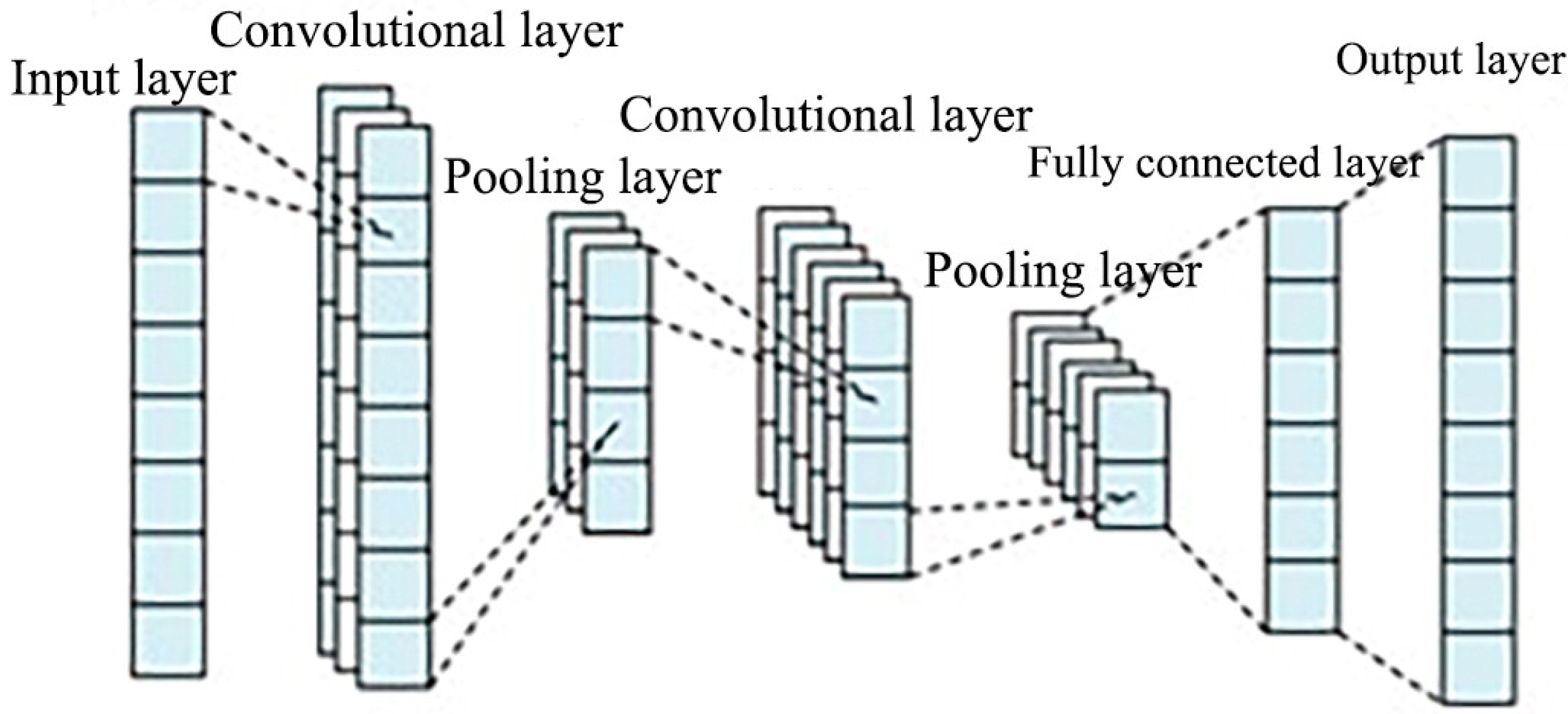

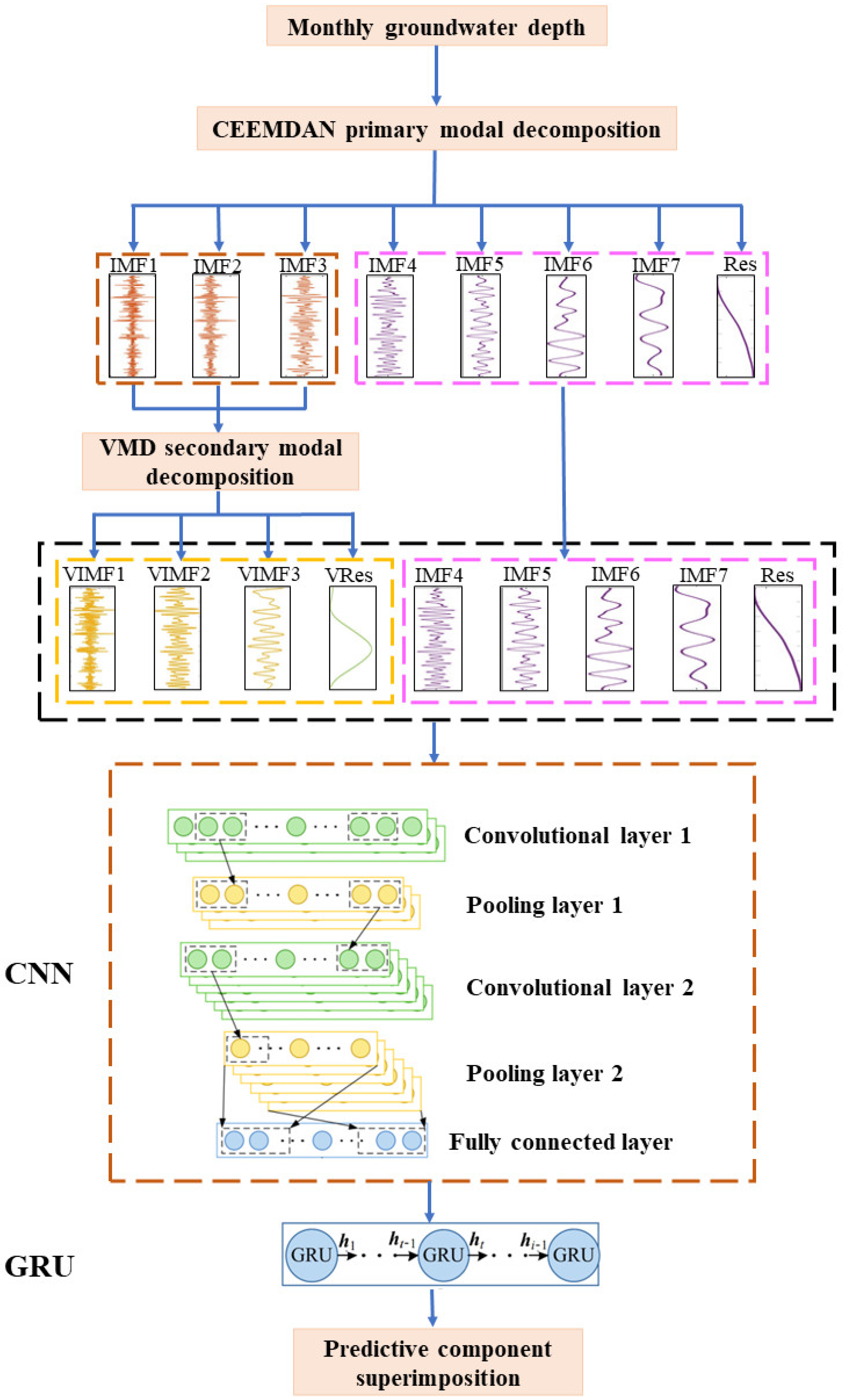

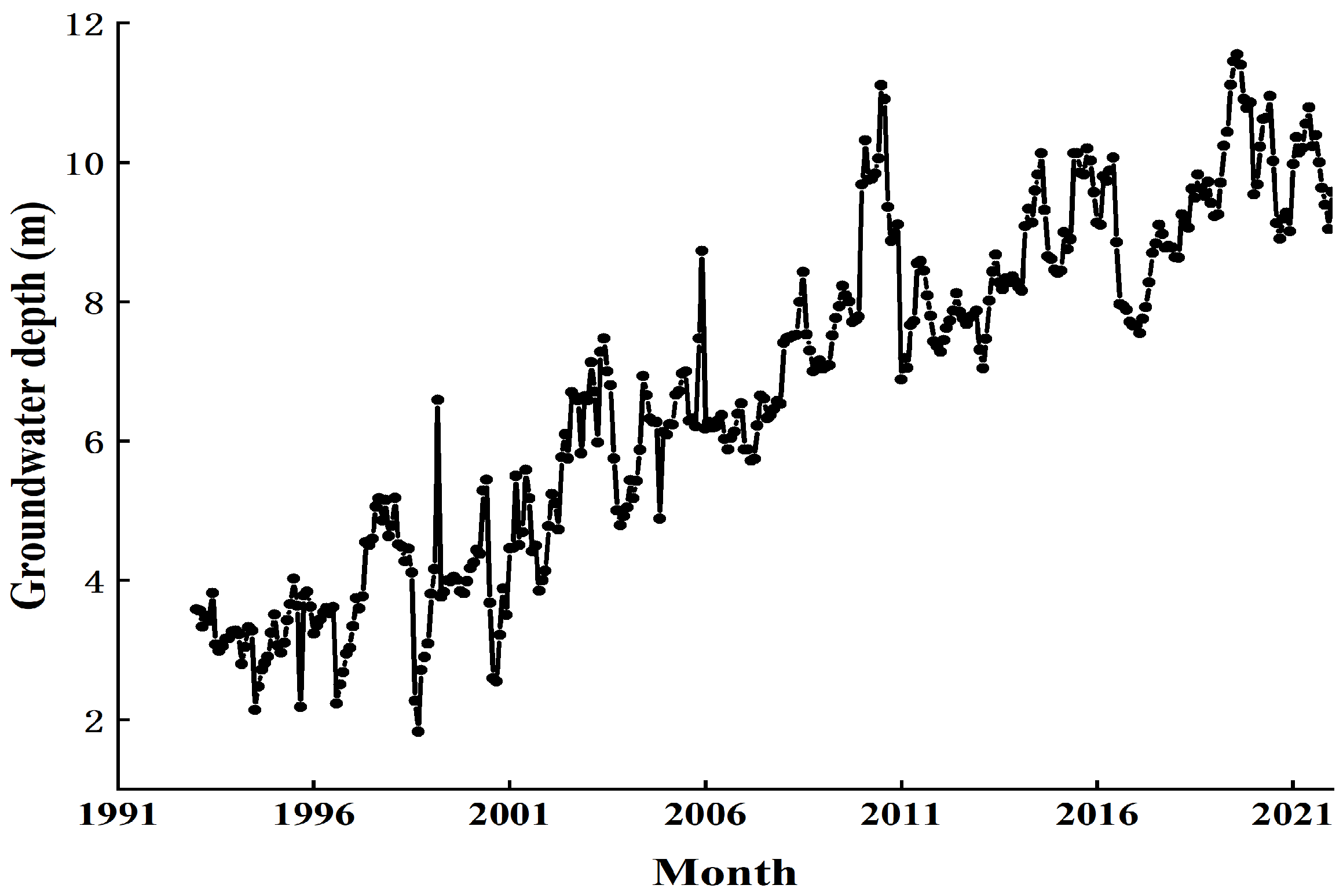
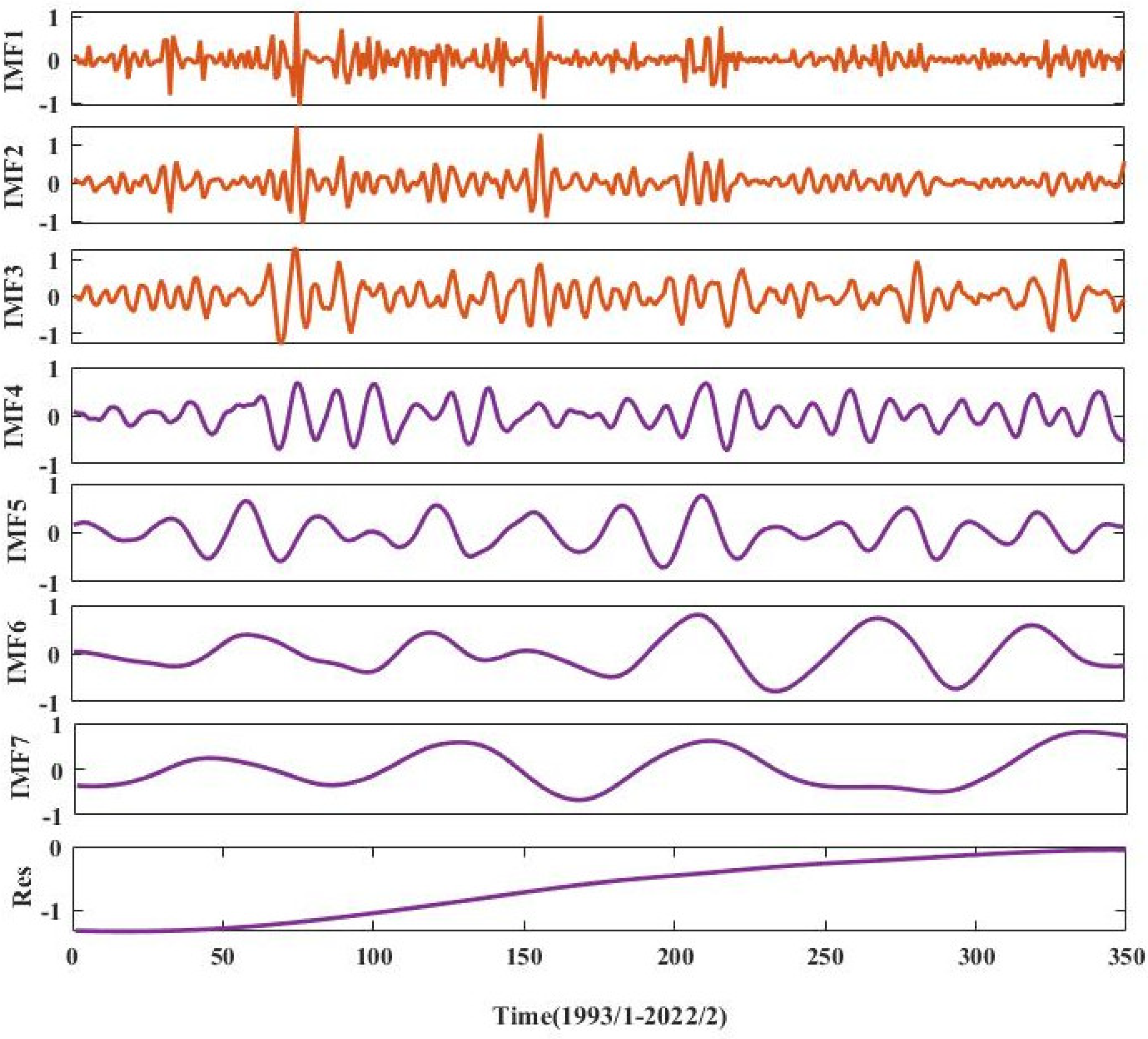

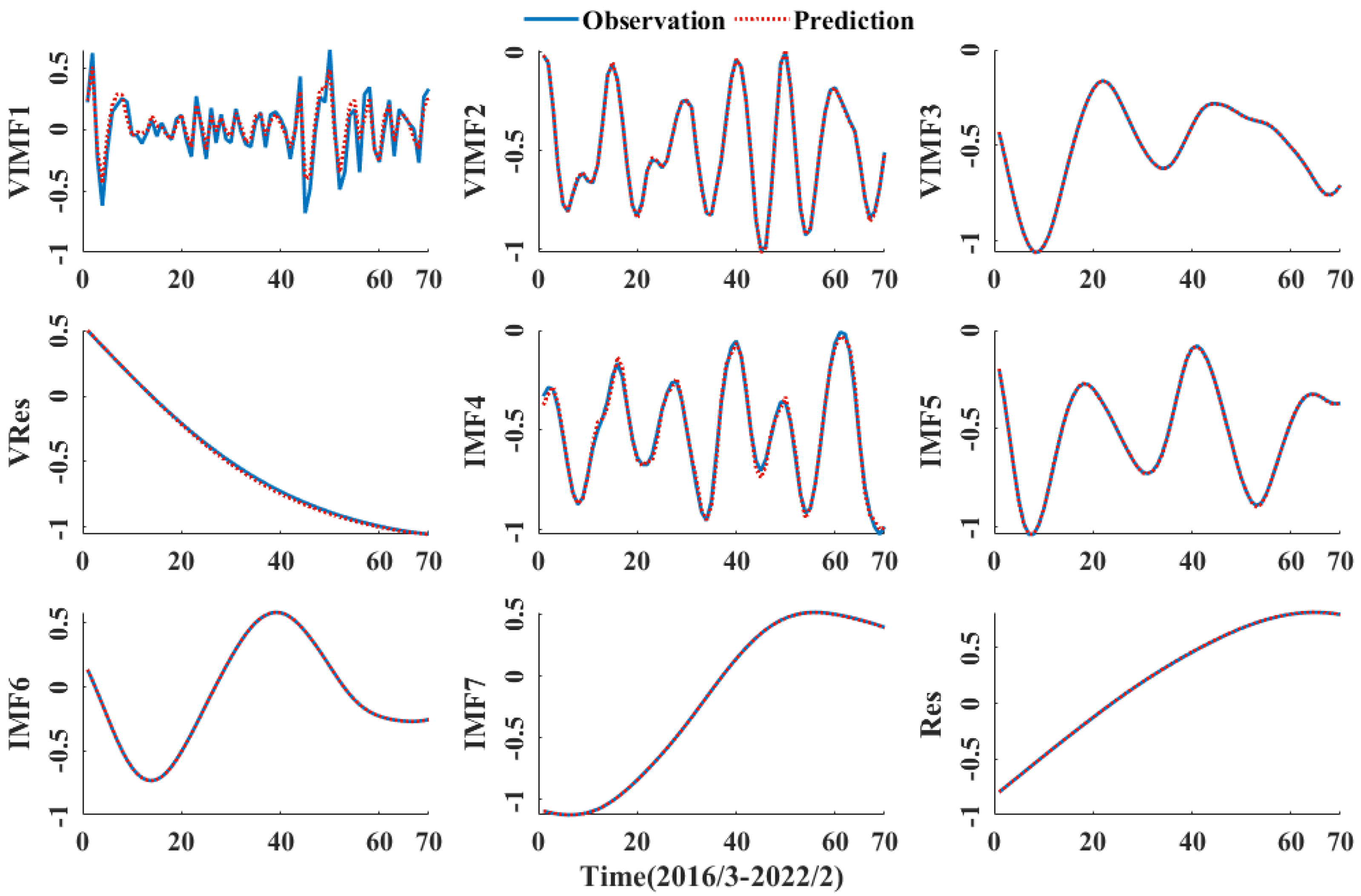
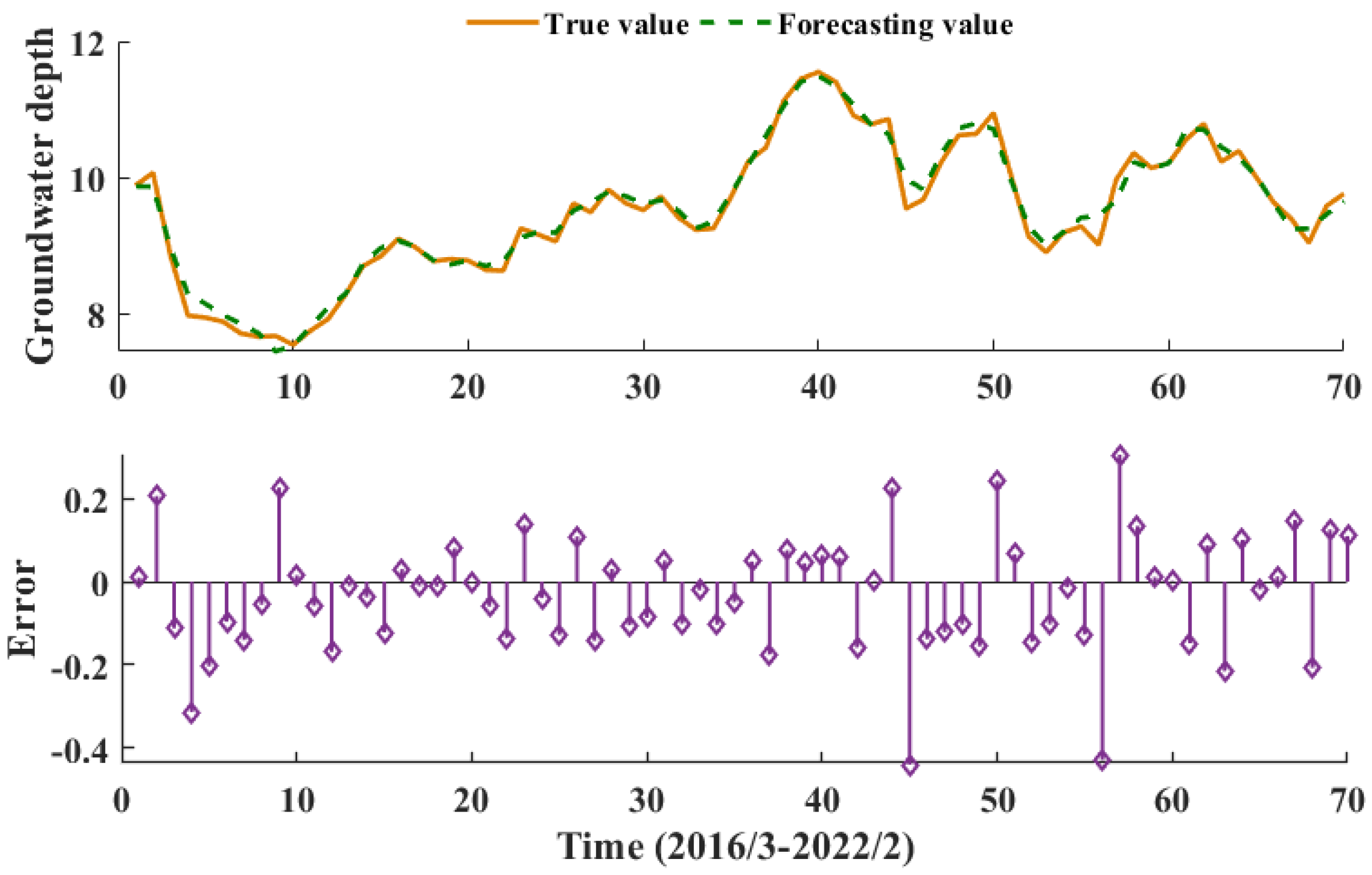
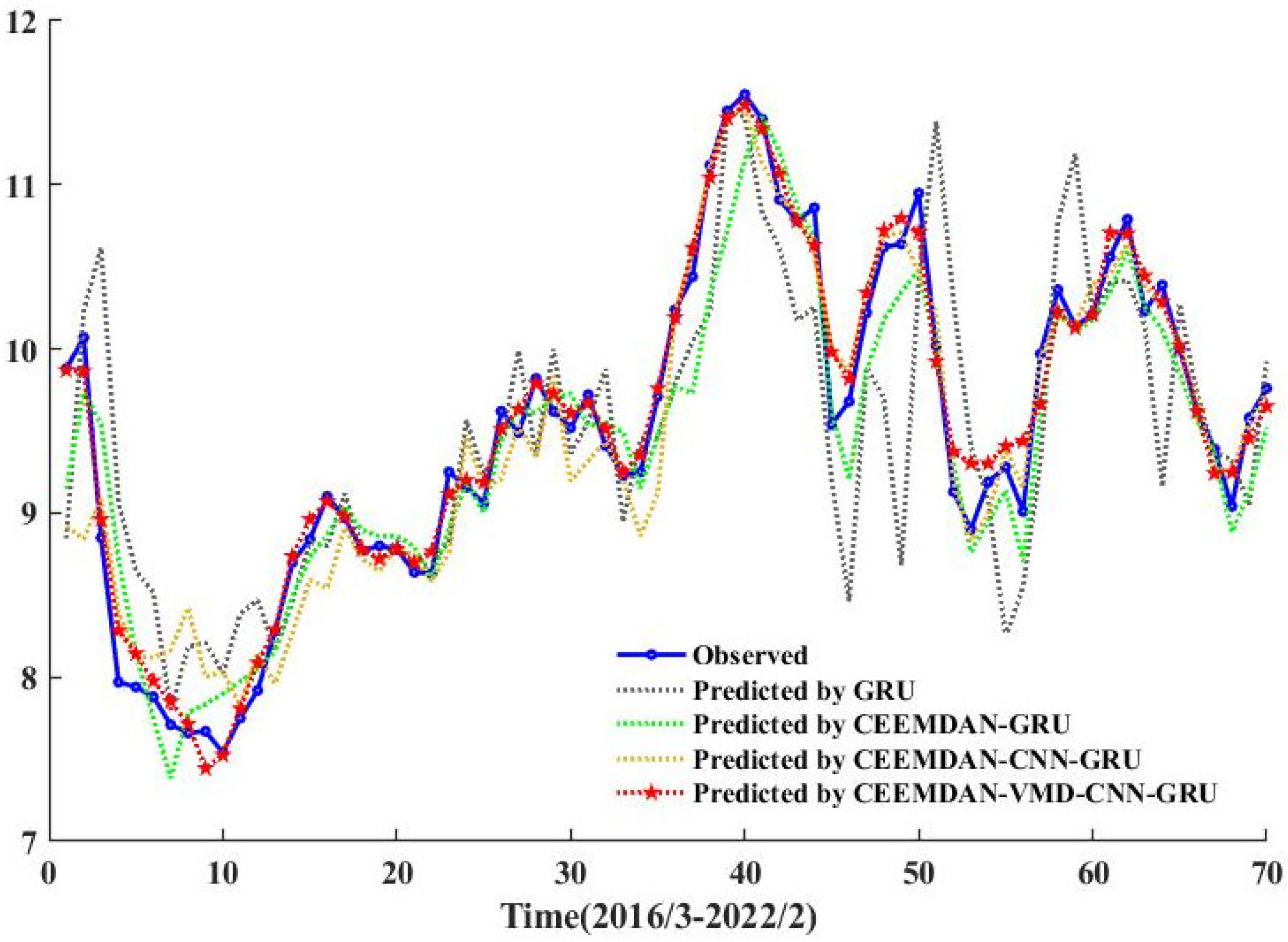

| Layer | Parameter | Value |
|---|---|---|
| Input | Time step | 1 |
| CEEMDAN | Noise standard deviation ratio | 0.2 |
| Number of noise additions | 300 | |
| Maximum number of allowed sieving iterations | 500 | |
| VMD | Modal number | 4 |
| Penalty Factor | 1500 | |
| Convergence tolerances | 2 × 10−6 | |
| CNN | Filters | 32 |
| Kernel_size | 32 | |
| Padding | same | |
| Activation function | ReLU | |
| GRU | Layers | 5 |
| Number of neurons | {64, 64, 64, 64, 64} | |
| Optimisation algorithms | Adam | |
| Batch_size | 20 | |
| Epochs | 80 | |
| Error | MSE |
| Evaluation Indicators | MAE (m) | RMSE (m) | NSE |
|---|---|---|---|
| VIMF1 | 0.1829 | 0.2371 | 0.0677 |
| VIMF2 | 0.0023 | 0.0029 | 0.9993 |
| VIMF3 | 0.0001 | 0.0001 | 0.9999 |
| VIMF4 | 0.0001 | 0.0001 | 0.9994 |
| IMF4 | 0.0176 | 0.0217 | 0.9935 |
| IMF5 | 0.0026 | 0.0032 | 0.9998 |
| IMF6 | 0.0005 | 0.0007 | 0.9999 |
| IMF7 | 0.0003 | 0.0004 | 1.0000 |
| Residual | 0.0005 | 0.0006 | 1.0000 |
| Overall | 0.1824 | 0.2363 | 0.9429 |
| Model | GRU | CEEMDAN-GRU | CEEMDAN-CNN-GRU | CEEMDAN-VMD-CNN-GRU |
|---|---|---|---|---|
| MAE | 0.3495 | 0.2747 | 0.2185 | 0.1824 |
| RMSE | 0.4672 | 0.3708 | 0.3149 | 0.2363 |
| NSE | 0.7768 | 0.8595 | 0.8986 | 0.9429 |
Disclaimer/Publisher’s Note: The statements, opinions and data contained in all publications are solely those of the individual author(s) and contributor(s) and not of MDPI and/or the editor(s). MDPI and/or the editor(s) disclaim responsibility for any injury to people or property resulting from any ideas, methods, instructions or products referred to in the content. |
© 2022 by the authors. Licensee MDPI, Basel, Switzerland. This article is an open access article distributed under the terms and conditions of the Creative Commons Attribution (CC BY) license (https://creativecommons.org/licenses/by/4.0/).
Share and Cite
Zhang, X.; Zheng, Z. A Novel Groundwater Burial Depth Prediction Model Based on Two-Stage Modal Decomposition and Deep Learning. Int. J. Environ. Res. Public Health 2023, 20, 345. https://doi.org/10.3390/ijerph20010345
Zhang X, Zheng Z. A Novel Groundwater Burial Depth Prediction Model Based on Two-Stage Modal Decomposition and Deep Learning. International Journal of Environmental Research and Public Health. 2023; 20(1):345. https://doi.org/10.3390/ijerph20010345
Chicago/Turabian StyleZhang, Xianqi, and Zhiwen Zheng. 2023. "A Novel Groundwater Burial Depth Prediction Model Based on Two-Stage Modal Decomposition and Deep Learning" International Journal of Environmental Research and Public Health 20, no. 1: 345. https://doi.org/10.3390/ijerph20010345
APA StyleZhang, X., & Zheng, Z. (2023). A Novel Groundwater Burial Depth Prediction Model Based on Two-Stage Modal Decomposition and Deep Learning. International Journal of Environmental Research and Public Health, 20(1), 345. https://doi.org/10.3390/ijerph20010345









